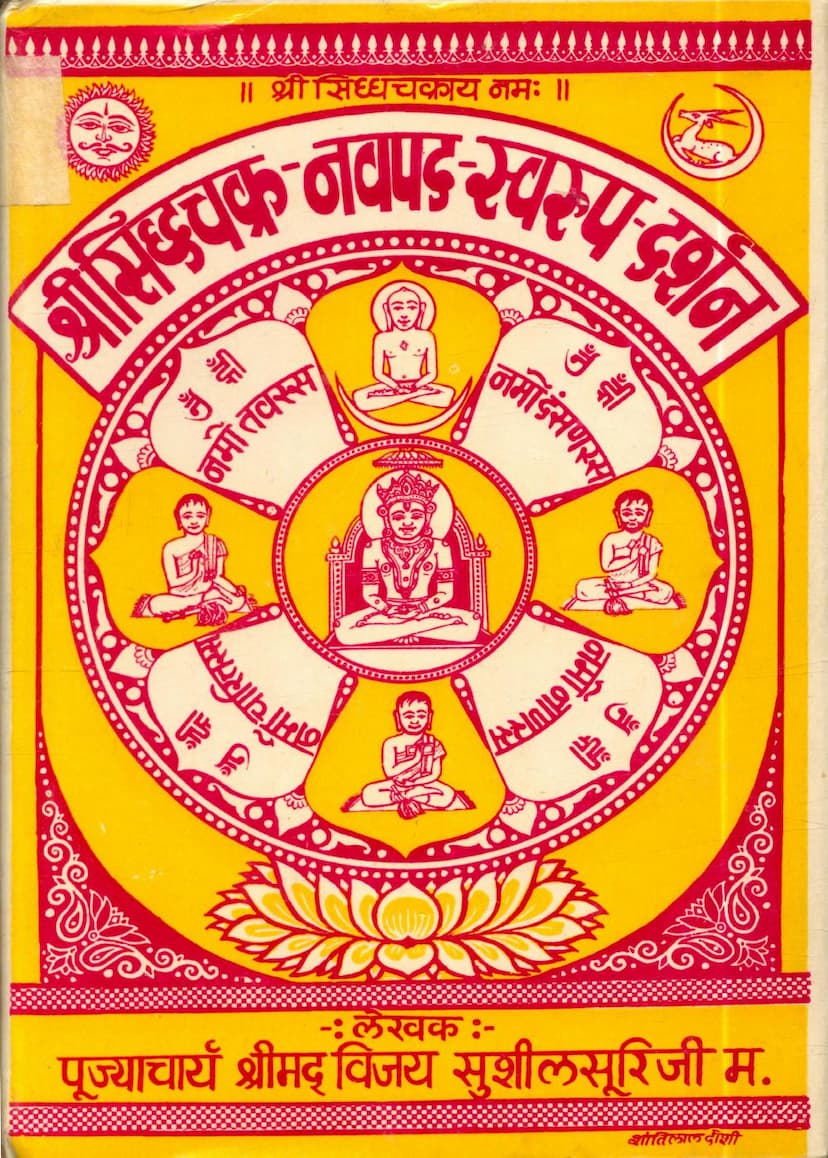Siddhachakra Navpad Swarup Darshan
Added to library: September 2, 2025

Summary
This document is a Jain text titled "Siddhachakra Navpad Swarup Darshan" authored by Sushilsuri, published by Sushilsuri Jain Gyanmandir. The provided text offers a comprehensive explanation of the Siddhachakra Navpad (Nine Sacred Syllables) within the Jain tradition.
Here's a breakdown of the key themes and content:
Core Message: The book focuses on the profound significance and practice of worshipping the Siddhachakra Navpad, which are considered the essence of Jainism. It emphasizes the spiritual and moral upliftment of humans, leading to peace and liberation (moksha).
Key Concepts and Structure:
-
Siddhachakra Navpad: The text meticulously details the nine sacred entities of the Siddhachakra:
- Arihant Pad (The fully enlightened ones)
- Siddha Pad (The liberated souls)
- Acharya Pad (The spiritual preceptors)
- Upadhyay Pad (The learned teachers)
- Sadhu Pad (The ascetics/monks)
- Darshan Pad (Right Faith)
- Gyan Pad (Right Knowledge)
- Charitra Pad (Right Conduct)
- Tapa Pad (Austerity/Asceticism)
-
Purpose of Worship (Aradhana): The book explains why the Navpad are worshipped, highlighting their role in overcoming worldly attachments, attaining spiritual progress, and ultimately achieving moksha.
-
Specific Time for Worship: It details the auspicious times for worshipping the Navpad, specifically mentioning the Ashwin (Sharad) and Chaitra (Vasant) months, during which a nine-day fast (Navpad Oli) is observed.
-
Significance of the Number Nine: The text delves into the symbolic importance of the number nine, stating it is an indivisible and complete number, mirroring the inseparability and completeness of the Navpad.
-
Detailed Description of Each Pad:
- Arihant Pad: Discusses the identification of an Arihant, their twelve virtues, thirty-four unique characteristics (pratiharyas and atishayas), their four great metaphors, and their primary position in the Navpad hierarchy. It explains why Arihant worship is associated with the color white.
- Siddha Pad: Explains the meaning of "Siddha," their eight ultimate virtues (anant gyan, anant darshan, etc.), their thirty-one derived virtues, their names, types, and the reason for their worship being associated with the color red. It also addresses why Siddhas are not the first to be saluted.
- Acharya Pad: Defines the role of an Acharya, their thirty-six virtues, and the significance of their worship being connected to the color yellow.
- Upadhyay Pad: Explains the role of an Upadhyay, their twenty-five virtues, and why their worship is associated with the color blue.
- Sadhu Pad: Details the characteristics of an ascetic (Sadhu), their twenty-seven virtues, their place in the Panch Parmesthi, and why their worship is linked to the color black.
- Darshan Pad: Describes Right Faith, its various classifications, its importance as the foundation for other spiritual practices, its symbolic white color, and the benefits of its attainment.
- Gyan Pad: Elaborates on Right Knowledge, its five types (mati, shrut, avadhi, manahparyav, keval), their various sub-classifications, their symbolic white color, and their significance.
- Charitra Pad: Explains Right Conduct, its importance as the path to liberation, its distinction between domestic and monastic practices, its various types (sāmayika, chedoppasthāpanīya, etc.), its seventy virtues, and its connection to the color white.
- Tapa Pad: Details the significance of Austerity, its twelve external and six internal types, its fifty virtues, its association with the color white, and its role in purification and karmic expulsion.
-
Practical Guidance: The text includes practical aspects like the daily rituals for the Navpad Oli, the significance of specific prayers and mantras, and the proper way to perform the worship.
-
Illustrative Stories and Examples: The book draws upon stories from Jain scriptures, such as the tale of King Shripal and Queen Mainamati, to illustrate the power and efficacy of worshipping the Navpad.
-
Dedication and Acknowledgements: The book is dedicated to the spiritual lineage of the author and acknowledges the contributions of various individuals and organizations involved in its publication. It highlights the author's (Acharya Sushil Suri's) dedication to making spiritual knowledge accessible in Hindi for the welfare of the masses.
-
Appendices: The document includes appendices detailing the rituals for Navpad Oli, hymns (Dhal) dedicated to the Navpad, and a description of a Chaturmas (four-month monastic retreat) held in Takhtgarh.
Overall Tone and Purpose: The book is written with a devotional and instructive tone, aiming to guide readers towards a deeper understanding and practice of the Siddhachakra Navpad worship. It emphasizes the transformative power of this practice for both worldly well-being and ultimate spiritual liberation. The author's intention is to spread the teachings of Jainism and promote spiritual awakening.